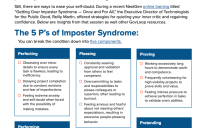The federal government’s executive branch is about to experience a massive overhaul. Whether you’re ready to usher in the change or are a little more hesitant, new department heads are being appointed and sworn in, the development of new mandates and budgets are already underway, and the entire executive branch is feverishly preparing to implement a new presidential agenda.
During this transition period, you’ve probably found yourself wondering what your agency mission looks like moving forward and how you fit into it during changing times. From the lowest GS levels all the way up to the senior executive service, federal civil servants are facing a test of thriving in the face of change.
In order to offer a little guidance to help you weather the storm, GovLoop brought together transition experts to explain what to expect during the presidential transition, how to overcome dueling priorities, and how to manage onboarding those coming in. On the latest edition of DorobekINSIDER Live, “What Gov Should Expect in 2017,” Christopher Dorobek moderated a conversation with David Eagles, Director of the Center for Presidential Transition at the Partnership for Public Service; and Mark Forman and Roger Baker, Mark Forman and Roger Baker and co-chairs of the transition effort conducted by the American Council on Technology and Industry Advisory Council (ACT-IAC) [PDF]. Forman is the former Administrator of e-Government and IT at the Office of Management and Budget; and Roger Baker, Former Chief Information Officer at the Department of Veterans Affairs to shed some light on these important topics.
Here are the five most important things we learned from their discussion:
Change is manageable. While change can be hard, our experts largely agreed that this transition is far from the end of the world. “I believe that the more things change, the more they stay the same and with this transition there are an awful lot of similarities to the 2008 transition,” Baker explained. He went on to compare the transition to a private sector company being acquired. “No one knows what is happening during this time and the best thing for career employees to do is to keep your head down and keep excelling at your job.”
Forman echoed this sentiment. “If you are a career employee working on good government initiatives, the new team will probably come in and keep these initiatives going. However, you also have to be prepared for this not to be the case.” While it’s hard to predict what is going to happen in the first months of the new administration, you can work on managing the change by staying cognizant of what’s happening and remaining diligent in your work.
The transition is going pretty well so far. Despite the unpredictability and scope of the transition, it is going relatively well so far due to teams starting early and utilizing the transition resources that the General Services Administration has provided. Eagles explained, “post-election is always a chaotic time but we are seeing the wheels of transition turning faster now than we have seen in the past as the new administration is prioritizing key positions and placing landing teams into agencies in a timely manner.” In order to sustain this momentum, Eagles also recommended that landing teams and new appointees focus on programs and initiatives that have worked in the last administration and maintain them in the new one.
You’ll be okay whether your job is safe or not. One of the biggest questions that the career workforce has going into the new administration is if their job is safe or not. The experts emphasized that certain employees are right to be concerned, especially those who are working on initiatives that the new administration clearly intends to not carry over. However, there are also a lot of programs that will have a place in government no matter who is in office. In order to alleviate the stress of uncertainty, Baker recommended, “make sure you are doing a good job no matter what program you are working on. If you are excelling it will be much easier to translate that success to the same program in a new administration or to another initiative in the government.”
Middle management will be crucial. While the federal government is comprised of the broader workforce, how employees are led will ultimately determine how well the workforce performs. “Great people who are poorly managed cannot do well in their jobs,” Baker said. “The caliber of people that you bring in at the Assistant Secretary and Under Secretary levels will make or break if the President’s and Secretary’s goals are effectively accomplished.”
Ultimately, career employees will get the job done but they will be able to accomplish so much more if they are guided by effective leadership. As the Administration begins to fill these middle management roles it will be crucial that they do so with individuals who have the skillset to do the job but also the managerial experience to lead the career workforce.
If you want to succeed, be helpful. As these political and middle managers begin to fill the halls of agencies, the best thing for career employees to do is be as helpful as you can. Baker advised knowing the incoming appointees’ agenda and quickly aligning your goals with theirs and gaining their trust. However, don’t be afraid to gently guide the new leadership to ideas that have consistently worked in the past. Forman recommended career employees rapidly form partnerships, “because there is power in numbers in the executive branch that can help you push your ideas.”
Ultimately, succeeding during the transition comes down to staying true to your work ethic and mission while remaining flexible to evolving agendas. “If you stay honest, be responsive, and remain patient, the transition is going to work itself out,” Eagles concluded.
Still a little apprehensive about the transition? Listen to the full online training here and check out GovLoop’s “How to Survive and Thrive in the Presidential Transition” guide here.






Thank you for this encouraging article!
Thank you for this optimistic and forward-moving piece 🙂 !